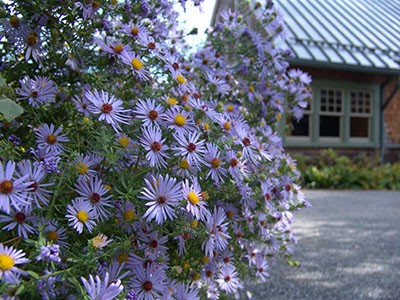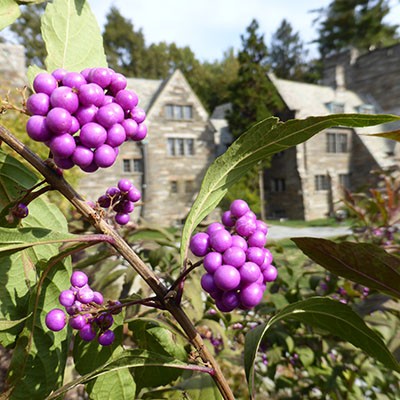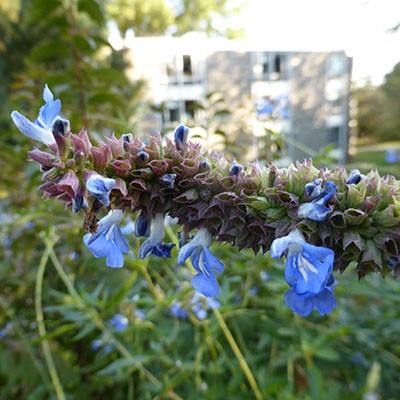Plants of the Week: October 19
Symphyotrichum oblongifolium ‘Raydon’s Favorite’
All growing season I stare at the green, undulating mound of Symphyotrichum oblongifolium ‘Raydon’s Favorite’ in the Entrance Garden and question its place in the garden. For most of the warm months it’s just a nondescript green. Then October rolls around and the saying, “to everything there is a season” comes to mind as the aromatic aster bursts into bloom. One can’t help but stare at the cloud of blue. Pollinators find it enticing too! Blooms occur over a near month-long period. North Creek Nursery recommends cutting back after flowering has concluded to prevent the spread of variable seedlings. Photo credit: R. Robert
Callicarpa [Purple Pearls®] = ‘NCCX1’
Callicarpa Purple Pearls®, planted in a mixed shrub border atop a retaining wall of the Bond Residence Hall Courtyard has caught my attention all season long. Clusters of pink flowers flanking the shrubs stems have given way to large mauve-purple fruits. Unlike other languid beauty berries the stems of Purple Pearls® are upright allowing one to appreciate the plant in fruit from afar. Leaves take on purple hues in autumn. Photo credit: J. Coceano
Salvia uliginosa
I’ve already wrote that I have a thing for salvia. If there was a downside to these diverse and colorful beauties it’d be that many aren’t winter hardy in our area. One exception has been Salvia uliginosa. Winter hardiness to zone 6a has been reported. The Brazilian native boasts sky blue flowers atop willowy 4’-6’ stems. Happy clumps expand over time. Despite the resemblance to the word ugly, the specific epithet is derived from the Latin word uliginos which means “damp”, “marshy”, or “wet” referring to the plants native habitat conditions. Despite this, the species is highly tolerant of dry soil conditions. Photo credit: J. Coceano








Bernadette
Posted at 13:28h, 24 OctoberHi. I sent an email to scott@swarthmore.edu 2 weeks ago. I had a question about your seedlings. I haven’t heard from them. In case this blog is maintained by the same people, I hope you get the chance to check your email and reply to my question. Thanks so much!
Nell Lancaster '74
Posted at 16:44h, 29 JanuaryHaving grown ‘Raydon’s Favorite’ aster for 15 seasons, during all of which it’s stayed in place after bloom to feed the birds (and provide a little cover), I can report that the seedlings are very difficult to tell from the originals, and don’t appear inferior in any way. It’s a plant I’d highly recommend to mid-Atlantic gardeners — long-lived, never fazed by unusually dry or wet years, and usefully extending color interest well into mid and late fall.
It’s easily removed where not wanted, and easy to divide where much more of it is wanted. The only caveat is for gardens with soil on the sandy/very friable end of the spectrum, where clumps expand more enthusiastically than they do in our stiff clay. I remember the garden friend who gave it to me saying “You’re SURE now; I don’t want you cussing me in a few springs…” Far from it!
Josh Coceano
Posted at 11:13h, 02 FebruaryHello Nell,
I agree -‘Raydon’s Favorite’ is a fantastic plant! I have seen quite a few seedlings generated from our plantings, though never in an invasive manner. The Garden Club of America has named the aster “plant of the year.” Thank you for sharing your observations.
Josh Coceano